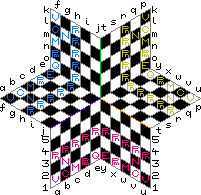Triple Crown
The problem of a three-player square-board variant was long ago - and probably more than once independently - solved by means of dividing the board Riverwise (into the two armies' halves), adding a third half, and turning and folding them so that each half borders half of each other half, always Kingside to Queenside. The reason for this last detail is that three Kingsides and three Queensides clear make pairing like with like all three times impossible, so pairing unlike with unlike three times is the most symmetric approach. Examples include Chess for 3, 3 Handed Chess, 3 Player Chess, and Yalta.What these variants have never developed is the three single-step moves straight across the centre of the board. They essentially treat the centre as a singularity, with orthogonal moves to a cell 60° round the centre and diagonal ones to a cell 120° round it, but none to the opposite one. This variant tackles the straight-across step by treating it as a very limited root-3 diagonal - more akin to the two-level cubic one than to the hex one because of the coexistence with the standard (root-2) diagonal and connecting cells of opposite Bishop bindings. This restricts pieces using it to the Viceroy and its compounds with square-board pieces. This suggested to me the threesomes (on cubic boards, and hence also on this one) of Crowned Rooks and Crowned Bishops which, as in most places triagonally-crowned pieces would behave the plain FIDE linepieces, pushed me to an array modelled on Duke of Rutland's Chess and my offshoot Modern Manners. The existence of three types of each gave me the name. I went for an extrapolation of a 10x10 board to 15x15, noting that with this kind of geometry each rank intersects only two-thirds of the files and vice versa.
Other variants of mine with a 6-cell centre are the "standard" 96-cell Fiancé Chess and the smaller Triana.
Setup

Pieces
The KNIGHT, QUEEN, and PAWN are the usual FIDE pieces. A Pawn capturing between its fourth and fifth ranks can go 120° round the centre either way, and having reached its fifth rank in one enemy half-board must continue further into that half-board, never entering the other one unpromoted.
Crowned Rooks:
The CHATELAINE, represented above by its initial C, is a Rook that can also make the one-step diagonal move of the Ferz. It cannot move straight across the centre of the board.
The VICEREINE, represented above by its initial V, is a Rook that can also, should it find itself on a centre cell, move to the opposite centre cell. It cannot move diagonally.
The BARONESS, not occurring in an array, is a Rook that can do both.
Crowned Bishops:
The PRIMATE, represented above by Pm (as distinct from Pn for the Pawn), is a Bishop that can also make the one-step orthogonal move of the Wazir. It cannot move straight across the centre of the board.
The MODERATOR, represented above by its initial M, is a Bishop that can also, should it find itself on a centre cell, move to the opposite centre cell. It cannot move orthogonally.
The POPE, not occurring in an array, is a Bishop that can do both.
Enhanced Royalty:
The EMPEROR, represented above by its initial E, is a King that can also, should it find itself on a centre cell, move to the opposite centre cell.
The DIARCH, not occurring in the array, is a Queen that can also, should it find itself on a centre cell, move to the opposite centre cell.
Rules
Pawns have an initial double-step move from the third rank, and can be captured En Passant by any enemy Pawn that could have captured normally had they moved only the single step.
Castling involves any of the following four pairs of moves, in abbreviated descriptive notation:
E-EM1 and EV-EPm1;
E-EM1 and EH-EPm1;
E-QM1 and QV-QPm1;
E-QPm1 and QC-Q1.
As usual all intermediate cells must be empty at the start of the move and no part of the Emperor's path may be in Check from either enemy.
A player must promote a Pawn reaching either far rank. If they no longer have the full quota of symmetric array pieces, and have no non-array pieces, they must promote it to one of the missing pieces. If they still have the full quota, or have regained it through previous promotion, they must promote it to a Baroness or a Pope, subject to not having more than one of either, or if they have both a Diarch. A player with a Baroness or Pope but not both must promote to the other, and one with both must promote to a Diarch.
A player whose Emperor is En Prise to the player about to move is Checkmated and their pieces removed from the board - but never forget the possibility of escaping Check straight across the centre! The checkmating player then makes their move and play proceeds with the remaining players. The first player checkmated loses and the last to survive wins. A player can also win instantly, regardless of the number of other remaining players, by getting a Pawn to a far rank when they already have all three non-array pieces. This 'user submitted' page is a collaboration between the posting user and the Chess Variant Pages. Registered contributors to the Chess Variant Pages have the ability to post their own works, subject to review and editing by the Chess Variant Pages Editorial Staff.
This 'user submitted' page is a collaboration between the posting user and the Chess Variant Pages. Registered contributors to the Chess Variant Pages have the ability to post their own works, subject to review and editing by the Chess Variant Pages Editorial Staff.
By Charles Gilman.
Web page created: 2006-12-09. Web page last updated: 2006-12-26